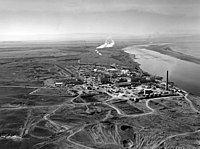
Photo from wikipedia
Objectives This study aimed to monitor the contamination by antineoplastic drugs on work surfaces in a compounding unit 4 years after its implementation. Methods This descriptive study was done in a… Click to show full abstract
Objectives This study aimed to monitor the contamination by antineoplastic drugs on work surfaces in a compounding unit 4 years after its implementation. Methods This descriptive study was done in a unit performing on average 45 000 preparations per year. Surface sampling points (N=23) were monitored monthly in the frame of routine activity from the opening of an anticancer drug compounding unit. Contamination with nine antineoplastic drugs (cyclophosphamide, ifosfamide, dacarbazine, 5-fluorouracil, methotrexate, gemcitabine, cytarabine, irinotecan and doxorubicin) was assessed on wipes with a local liquid chromatography coupled with a tandem mass spectrometer analysis. The contamination rate (CR, %) was prospectively monitored every month during the entire study period. The occurrence of critical incidents was also registered. The effect of each safety measure implemented during this period was also analysed. Results Based on the 1104 samples collected between March 2016 and March 2020, the CR was 18.5%. If three different critical incidents among a vial breakage that occurred were individually considered, this CR was slightly lower than that in the literature. Eight months after opening and taking different corrective actions, the overall CR dropped from 42.39% to 11.52% (p<0.001). Contamination was limited to the area that includes the compounding room and, more precisely, the welder and the QC-Prep+ sampling points. Conclusions From the beginning of the study and from month to month, surface contamination was limited to the nearest sampling points to the compounding unit. This 4-year monitoring study allowed us to determine the intravenous conventional antineoplastic drugs and sampling points to be focused on.
Journal Title: Occupational and Environmental Medicine
Year Published: 2023
Link to full text (if available)
Share on Social Media: Sign Up to like & get
recommendations!